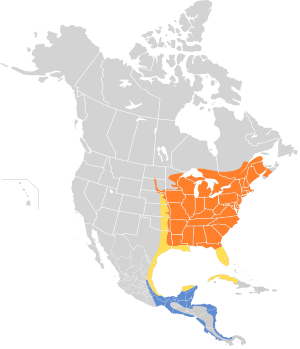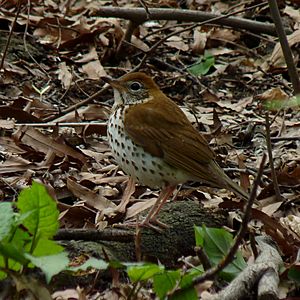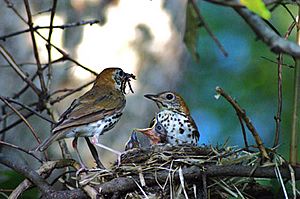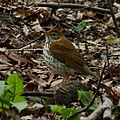Wood thrush facts for kids
Quick facts for kids Wood thrush |
|
|---|---|
 |
|
| Conservation status | |
| Scientific classification | |
| Genus: |
Hylocichla
|
| Species: |
mustelina
|
 |
|
| Synonyms | |
|
Catharus mustelinus |
|
The wood thrush (Hylocichla mustelina) is a type of passerine bird found in North America. It is related to other thrushes, like the American robin. This bird lives across North America and spends its winters in Central America and southern Mexico. The wood thrush is the official bird of District of Columbia.
The wood thrush is a medium-sized thrush. It has brown feathers on its back and mottled brown and white feathers underneath. Male and female wood thrushes look very similar. Many people say the male's song is the most beautiful in North America.
This bird is an omnivore, meaning it eats both plants and animals. It mostly eats small creatures from the soil and their young, but it also enjoys fruits. In summer, it eats insects all the time to get enough energy. The wood thrush usually lives alone. However, sometimes it joins groups with other types of birds. It defends its own space, called a territory, which can be quite large. Wood thrushes are monogamous, meaning they have one mate during the breeding season. This season starts in spring. About half of all pairs raise two groups of young, with each group having two to four chicks.
Contents
About the Wood Thrush Name
The wood thrush is the only bird in its group, called Hylocichla. A German naturalist named Johann Friedrich Gmelin first described this bird in 1789.
The name Hylocichla comes from old Greek words. Hyle means "woodland" and cichle means "thrush". So, its scientific name literally means "woodland thrush". The second part of its name, mustelina, comes from the Latin word mustela, which means "weasel".
The official name for this bird, "wood thrush," was given by the International Ornithologists' Union.
What the Wood Thrush Looks Like

An adult wood thrush is about 18 to 21.5 centimeters (7 to 8.5 inches) long. Its wings can spread out 30 to 40 centimeters (12 to 16 inches) wide. It weighs about 48 to 72 grams (1.7 to 2.5 ounces). It is bigger than some other thrushes but a bit smaller than the common American robin. The longest a wood thrush has lived in the wild is almost 9 years.
The top of its head, neck, and upper back are cinnamon-brown. Its wings and tail are a slightly duller brown. Its chest and belly are white with large, dark brown spots. It has white rings around its eyes and pink legs. Young wood thrushes look like adults but have more spots on their back, neck, and wings. Male and female wood thrushes are similar in size and feather color.
The Wood Thrush's Song
Many people believe the wood thrush has one of the most beautiful songs of any North American bird. The famous American writer Henry David Thoreau once wrote about its song, saying it makes you feel young and like nature is new.
Only the male wood thrush sings. Its song is special because it has three parts. The first part is often quiet and hard to hear unless you are close. It sounds like two to six short, low notes, such as bup, bup, bup. The middle part is a loud phrase, often sounding like ee-oh-lay. The third part is a trill-like sound, where the bird rapidly sings two notes at once.
The male wood thrush can actually sing two notes at the same time! This gives its song a magical, flute-like sound. Each bird has its own unique song, made from different combinations of these three parts. The songs are often repeated in order. The bup, bup, bup sound can also be used as a call. It gets louder and faster when the bird is upset. Wood thrushes also use a tut, tut sound to show they are agitated. When flying at night, they make a strong buzzing sound like heeh.
Where Wood Thrushes Live
The wood thrush breeds from southern Canada (Manitoba, Ontario, Nova Scotia) down to northern Florida. Its range stretches from the Atlantic coast to the Missouri River and the eastern Great Plains.
In winter, it migrates south to southern Mexico and through Panama in Central America. They mostly stay in low areas along the Atlantic and Pacific coasts. They usually arrive on the U.S. Gulf Coast in early April. Their journey south for winter usually starts in mid-August and lasts until mid-September. They travel at night, using the stars and the Earth's magnetic field to find their way.
The wood thrush likes to breed in deciduous and mixed forests. They prefer older, moist forests with a good amount of shrubs. They like areas with running water, damp ground, and lots of cover from plants. Their breeding homes usually have trees taller than 16 meters (52 feet), an open forest floor, moist soil, and leaf litter. They can breed in small forest areas, but this can lead to more danger from predators and other birds laying eggs in their nests.
Conservation Status
The number of wood thrushes has dropped by about 50% since 1966. This makes them a symbol of the decline of songbirds in eastern North America. Like many other birds, they face dangers both in their North American breeding areas and their Central American winter homes.
Forests being broken up into smaller pieces in North America means more nests are attacked by predators. Also, more brown-headed cowbirds lay their eggs in wood thrush nests, which reduces how many wood thrush chicks survive. A study by the Cornell Lab of Ornithology found a link between acid rain and the decline of this thrush. Also, the destruction of old forests in Central America removes their favorite winter homes. This forces them to live in less suitable places where they might not survive as well. Even with these challenges, the wood thrush is currently listed as a species of Least Concern.
Wood Thrush Behavior
The wood thrush usually lives alone. However, in winter, it sometimes joins groups with other bird species. Its breeding territory is used for nesting, finding materials for nests, and searching for food. Some wood thrushes also protect a feeding area in winter.
When birds argue over territory, they usually don't fight physically. But if they are very upset or defending their nest, they might use their feet or beak to fight. To scare away predators near their nest, they might flick their wings or tail, or raise the feathers on their head. Sometimes, they will even dive at or hit the predator.
This bird also does something called "anting." This is when a bird picks up one or more ants and rubs them on its feathers. Scientists are not sure why they do this. It might be that the ants give off chemicals that help the birds, perhaps for cleaning their feathers or for health reasons.
What the Wood Thrush Eats
The wood thrush is an omnivore. It mainly eats small creatures and their young found in the soil. But in late summer, fall, and late winter, it also eats fruits. Sometimes, it eats insects from trees, snails, and small salamanders. Young wood thrushes are fed insects and some fruit. Before they migrate for winter, adult wood thrushes change their diet from mostly insects to fruits that are high in fat. In summer, they need to eat insects all the time to get enough energy because there isn't much fruit.
The wood thrush mostly looks for food on the forest floor. It uses its beak to flip over leaves to find insects hiding underneath. You can often see it hopping around in leaf litter and on bare ground under the trees. It swallows fruits whole.
Who Eats the Wood Thrush?
Wood thrush eggs and chicks can be eaten by many animals. These include chipmunks, raccoons, blue jays, American crows, black rat snakes, brown-headed cowbirds, common grackles, southern flying squirrels, gray squirrels, least weasels, white-footed mice, and domestic cats. Adult wood thrushes are mostly hunted by hawks and great horned owls.
Wood Thrush Reproduction and Life Cycle
Wood thrushes are monogamous, meaning they stay with one mate during the breeding season. Pairs form in mid-April to early-May and usually stay together for the whole season. Most thrushes find a new mate each year.
Some male wood thrushes arrive at the breeding grounds a few days before the females. Other males arrive at the same time as the females. They set up territories that can be from 0.08 to 0.8 hectares (about one-fifth of an acre to two acres) in size. The female usually starts flying in silent circles, about 1 to 1.8 meters (3 to 6 feet) off the ground, with the male following her. They often do six or more of these flights in a row. Between flights, the pair will sit together and feed each other.
The male starts singing at dawn and dusk a few days after arriving. Early in the breeding season, he sings from high up in the tallest trees. As the season goes on, he sings shorter, simpler songs from lower branches. Each day's singing is strongest just before sunrise. The male might sing all day, but especially at dusk. The singing season usually ends by late July.
The female usually chooses where to build the nest and builds it herself. The nest is often hidden in a dense group of plants in a tree or shrub, providing shade. It is usually made of dead grasses, stems, and leaves, and lined with mud. The nest is placed in a fork of a horizontal branch. They do not reuse nests.
Wood thrushes usually try to raise two groups of young each year. They might build three or four separate nests before they succeed. The female lays two to four pale blue eggs, one egg per day. Only the female sits on the eggs to keep them warm, which takes 11 to 14 days (usually 13 days).
When the chicks hatch, they are altricial. This means they are mostly naked and their eyes are closed. The female keeps the chicks warm for the first four days after they hatch. Both parents feed the nestlings and clean the nest by removing waste. The chicks leave the nest 12 to 15 days after hatching. However, their parents continue to feed them until they can take care of themselves and leave their parents' territory, which happens when they are 21 to 31 days old.
Young wood thrushes can start breeding the next summer. Most females lay their first eggs in mid-May, but older females might start earlier. Pairs usually try to raise a second group of young by late July, with the last chicks leaving the nest around mid-August. About half of all wood thrush pairs successfully raise two groups of young.
Images for kids
See also
 In Spanish: Zorzal maculado para niños
In Spanish: Zorzal maculado para niños






